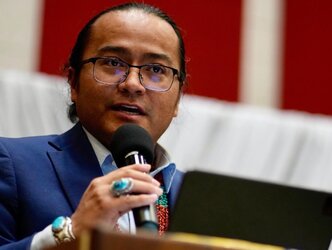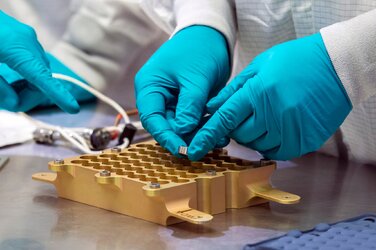STEPHEN CLARK - 1/6/2024

The Moon sets over sandstone formations on the Navajo Nation.
Science instruments aren't the only things hitching a ride to the Moon on a commercial lunar lander ready for launch Monday. Two companies specializing in "space burials" are sending cremated human remains to the Moon, and this doesn't sit well with the Navajo Nation.
The Navajo people, one of the nation's largest Indigenous groups, hold the Moon sacred, and putting human remains on the lunar surface amounts to desecration, according to Navajo Nation President Buu Nygren.
"The sacredness of the Moon is deeply embedded in the spirituality and heritage of many Indigenous cultures, including our own," Nygren said in a statement. "The placement of human remains on the Moon is a profound desecration of this celestial body revered by our people."
Last month, Nygren wrote a letter to NASA and the Department of Transportation, which licenses commercial space launches, requesting a postponement of the flight to the Moon. The human remains in question are mounted to the robotic Peregrine lander, built and owned by a Pittsburgh-based company named Astrobotic, poised for liftoff from Cape Canaveral Space Force Station in Florida on top of United Launch Alliance's Vulcan rocket.
This is the second time a US spacecraft has gone to the Moon with human remains aboard. In 1998, NASA's Lunar Prospector mission launched with a small capsule containing the ashes of Eugene Shoemaker, a pioneer in planetary geology. NASA intentionally crashed spacecraft into the Moon in 1999, leaving Shoemaker's ashes permanently on the surface.
At that time, officials from the Navajo Nation objected to the scattering of Shoemaker's ashes on the Moon. NASA promised to consult with tribal officials before another spacecraft flew to the Moon with human remains. A big part of Nygren's recent complaint was the lack of dialogue on the matter before this mission.
"This act disregards past agreements and promises of respect and consultation between NASA and the Navajo Nation, notably following the Lunar Prospector mission in 1998," Nygren said in a statement. He added that the request for consultation is "rooted in a desire to ensure that our cultural practices, especially those related to the Moon and the treatment of the deceased, are respected."
An oversight
Officials from the White House and NASA met with Nygren on Friday to discuss his concerns. Speaking with reporters after the meeting, Nygren said he believes it was an oversight that federal officials didn't meet with the Navajo Nation at an earlier stage.“I think being able to consult into the future is one of the things that they’re going to try to work on," he told reporters Friday. While Nygren said that was good to hear, "we were given no reassurance that the human remains were not going to be transported to the Moon on Monday."
Removing the human remains would delay the launch at least several weeks. It would require removing Astrobotic's lunar lander from the top of the Vulcan rocket, taking it back to a clean room facility, and opening the payload fairing to provide access to the spacecraft.
"They’re not going to remove the human remains and keep them here on Earth where they were created, but instead, we were just told that a mistake has happened, we’re sorry, into the future we’re going to try to consult with you," Nygren said.
"We take concerns expressed from the Navajo Nation very, very seriously," said Joel Kearns, deputy associate administrator for exploration in NASA's science directorate. "And we think we're going to be continuing this conversation."

Buu Nygren, president of the Navajo Nation.
Astrobotic's mission is different from Lunar Prospector in one important sense. The Peregrine lander is privately owned, while Lunar Prospector was a government spacecraft. NASA has a $108 million contract with Astrobotic to deliver the agency's science payloads to the Moon as a commercial service. Astrobotic's mission is the first time a US company will attempt to land a commercial spacecraft on the Moon.
While Nygren argues that NASA's role as Astrobotic's anchor customer should give the agency some influence over decision-making, the government's only legal authority in overseeing the mission is through the Federal Aviation Administration.
The FAA is responsible for ensuring commercial launches, like the Vulcan rocket flight Monday, don't put public safety at risk. The launch licensing process also includes an FAA review to ensure a launch would not jeopardize US national security, foreign policy interests, or international obligations.
"For our own missions ... NASA works to be very mindful of potential concerns for any work that we'll do on the Moon," Kearns said. "In this particular case ... NASA really doesn't have involvement or oversight."
A tenet of NASA's strategy for lunar exploration is to partner with commercial companies. In the end, NASA wants to be one of many customers buying transportation services to the Moon, reducing costs to taxpayers.
Astrobotic sold capacity on its lander to several customers, mainly NASA, which is sending a radiation sensor, spectrometers, and a laser retroreflector array to the Moon aboard the Peregrine lander. This is the first launch for NASA's Commercial Lunar Payload Services (CLPS) program established in 2018 to purchase flights to the Moon for scientific and technology demonstration experiments.
"These are truly commercial missions," said Chris Culbert, NASA's CLPS program manager. "It's up to them to sell what they can sell. But in the process of making sure that our payloads needs are being met, we obviously have a lot of discussions about how the payloads fit together."
There's also a small lunar rover developed at Carnegie Mellon University, and five tiny robots—each less than a tenth of a pound—from the Mexican Space Agency that will deploy onto the lunar surface. Some of Astrobotic's customers are sending commemorative plaques and mementos to the Moon. Then, there are Celestis and Elysium Space. These two companies gathered human ashes from families paying to send the remains of their loved ones for an eternal stay on the lunar surface.
Celestis, headquartered in Houston, says it has 20 completed "memorial spaceflights" since the 1990s. "If you’ve ever longed to travel in space, or stepped outside on a starry night and felt at home, we invite you to consider one of the following memorial spaceflight services for yourself or a loved one," Celestis writes on its website.
Launching your loved one's ashes on the Moon creates a "a permanent memorial on a distant, but constantly viewable world," Celestis says. The company charges $13,000 to land a small amount human remains on the Moon.

Technicians prepare capsules containing ashes and human DNA for liftoff on United Launch Alliance's Vulcan rocket.
This mission, which Celestis calls Tranquility Flight, will carry the cremated remains or DNA of 66 people to Astrobotic's landing site at Gruithuisen Domes, the site of an ancient volcanic eruption on the near side of the Moon. The list of participants on Tranquility Flight include science fiction writer Arthur C. Clarke and Star Trek creator Gene Roddenberry.
Elysium Space has not released details about exactly what it will send to the Moon on the Peregrine lander. Astrobotic's description of Elysium's payload says it will "deliver a symbolic portion of remains" to the lunar surface.
Nygren said the Navajo Nation does not oppose rocket launches or space exploration, but he is concerned about the lack of oversight and regulation of non-NASA commercial payloads.
"As stewards of our culture and traditions, it is our responsibility to voice our grievances when actions are taken that could desecrate sacred
spaces and disregard deeply held cultural beliefs," he said.
Charles Chafer, CEO of Celestis, pushed back on the Navajo Nation objections in an interview with Marcia Smith of SpacePolicyOnline.com. "Nobody owns the Moon" and there is “no religious test for the conduct of space activities,” he said.
"We reject the whole premise that this is somehow desecration," Chafer said. "We handle these capsules reverently. We do not scatter them on the lunar surface. We object to the entire characterization of our service that I read in the letter. It’s the antithesis of desecration. It’s celebration.”